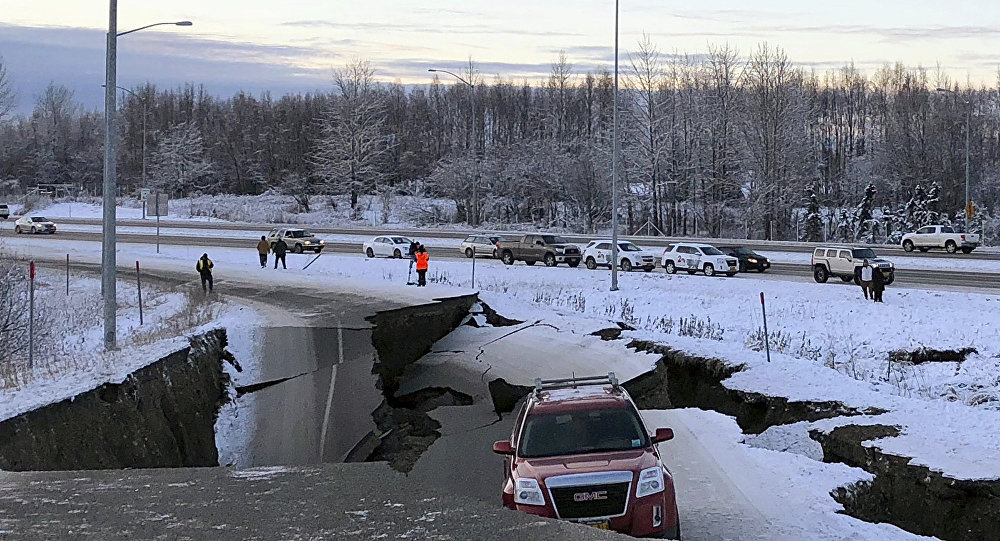News trend
Why a powerful Alaska earthquake cracked roads but should cause few fatalities
Why a powerful Alaska earthquake cracked roads but should cause few fatalities
Just before 8:30 a.m. local time on November 30, a magnitude 7 earthquake rattled southern Alaska. The waves rumbled from an epicenter just eight miles north of Anchorage, the state’s most populated city—downing power lines, collapsing roads, and sending people fleeing for cover. A tsunami warning was issued soon after the shaking started, but it was lifted by 10:00 a.m. local time.
The quake was “certainly a pretty big one,” says Ben Andrews, the director of the Smithsonian’s Global Volcanism Program. So far, reports suggest that the earthquake and its aftershocks were tough on the region’s infrastructure, but very few fatalities are expected, in part because Alaska is prepared for such an event.
The region is the most earthquake-prone in the United States, with an average of one magnitude 7 to 8 temblor striking each year since 1990. In 1964, a magnitude 9.2 earthquake that shook the region became the largest yet recorded in the United States. The intense shaking and subsequent tsunamis killed 131 people.
As reports of the aftermath from this latest earthquake roll in, you might have some questions: Why did it happen? How bad will the damage get? And how does Alaska prepare for such disasters? We’ve got you covered.

Why are earthquakes common in Alaska?
Nestled off Alaska’s southern shoreline, the Aleutian Trench is a deep oceanic groove that is the result of colliding tectonic plates—the ever-shifting slabs of rock that make up Earth’s surface. The Aleutian Trench forms where the northern edge of the Pacific plate plunges deep underneath the North American plate.
The plates don’t move fast: they shift at roughly the speed at which your fingernails grow, or just a few centimeters a year, Andrews says. But they don’t slide smoothly against one another. Instead, the plates grind together and build up strains and stresses in the crust. This slow-motion collision is the source the region’s numerous earthquakes and the creator of the volcanoes that make up the Aleutian Islands.
Importantly, the November 30 earthquake was not related to any volcanic activity, according to the Alaska Volcano Observatory. It also wasn’t directly related to the subduction zone, explains Paul Caruso, a geophysicist with the U.S. Geological Survey.

“As the Pacific plate is pushing underneath Alaska, it’s causing all kinds of other stresses and strains on the crust,” he says. Occasionally, these stresses build up so much, they must release and rupture a fault. “Then you have something like a hundred years or a hundred thousand years of motion happen in matter of seconds or minutes”—aka, an earthquake, Andrews says.
Magnitude 7 sounds large—why are so few fatalities expected?
Magnitude is a measure of an earthquake’s energy release, and it can only tell you so much about what any given event feels like at the surface. Differences in regional geology and even the depth of the quake can affect how much the locals feel Earth’s trembles.
While details are still emerging about the specific fault that let loose in this case, researchers believe that the rupture was centered relatively deep in the Earth, roughly 25 miles below the surface. That’s good news for locals, says Caruso.
“Shallow quakes cause more shaking, so the depth of this quake actually contributed to less shaking,” he says. Damage is also limited thanks to the low population density of the city and the lack of high-rise buildings.
“It’s not like this is happening in downtown Manhattan or something,” Andrews says. In addition, the region has strict building standards, limiting any possible damage, Caruso says.
“In other parts of the world—or even other parts of the United States—this magnitude quake could almost certainly result in fatalities,” Andrews says, “and we can very much hope that there won’t be any in Alaska.”

What are the risks in the aftermath?
There are, of course, still concerns. While details continue to emerge about the severity of events, initial reports suggest there is a great deal of infrastructure damage in the region. The USGS estimates there’s a 35 percent chance of between a hundred million and a billion dollars of economic damage in the region.
“Many homes and buildings are damaged. Many roads and bridges are closed,” according to an Anchorage Police Department statement, which also notes that the department has dispatched officers thought the region for assistance.
With geologic jittering so large, loose sediments or sand tend to act more fluid than solid, causing trees to tilt and buildings to sink. But for now, it’s unclear how much of this so-called liquefaction has resulted from the shaking. Aftershocks are also still ricocheting through the region. Residents should listen to local authorities and take appropriate precautions while weathering aftershocks.
“Stay off the roads if you don’t need to drive. Seek a safe shelter,” the Anchorage Police Department notes. “Check on your surroundings and loved ones.”

